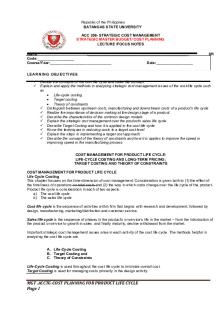Chapter 8 lecture notes PDF

| Title | Chapter 8 lecture notes |
|---|---|
| Course | College Chemistry I |
| Institution | University of Missouri |
| Pages | 1 |
| File Size | 49.5 KB |
| File Type | |
| Total Downloads | 48 |
| Total Views | 164 |
Summary
lecture notes for chapter 8...
Description
Chapter 8 Quantities in Chemical Reactions Stoichiometry - the study of the numerical relationships between chemical quantities of reactants and products in the chemical reaction. - Everything is consumed in the reaction as written down in the form of a balanced chemical equation Mass of a Compound Produced or Consumed in a Reaction - 2 conversion factors needed: - Molar mass is one conversion factor. - Molar ratio from a balanced equation is another. Theoretical vs Actual Yields - The amount of product calculated from the equation (taking into account limiting reagent) is the theoretical yield. - When you run a reaction, the amount of product collected is the actual yield. - These may not be the same because a fraction of the product may spill, escape as gas, stay deposited on the walls of the test tubes etc. - There is also such thing as human error ... - The percent yield is the amount of the actual yield compared to the theoretical yield. - actual/theoretical x 100% = percent yield Enthalpy of a Reaction - In a chemical reaction, energy is gained or lost. - Products may contain less or more energy than reactants. - Energy produced or consumed in the reaction is called the enthalpy of reaction: ΔHrxn. - Exothermic - heat released to surrounding - Endothermic - heat absorbed from surroundings Exothermic Process - A type of reusable instant HOT packs produces heat by crystallization of sodium acetate. - Precipitation is initiated by compressing a metal disk within the pouch of supersaturated NaCH3COO solution. The process is exothermic and the pouch warms up as the salt crystallizes. Enthalpy and Chemical Equation - Enthalpy of reaction (ΔHrxn) follows molar ratios of the balanced equation and is listed to the right of the equation. - Combustion of iron metal is an exothermic reaction that releases 1652 kJ of heat per mole of balanced reaction: - Energy is produced by the reaction, so the sign for the enthalpy is negative....
Similar Free PDFs

Chapter 8 - Lecture notes 8
- 7 Pages

Chapter 8 - Lecture notes 8
- 2 Pages

Chapter 8 - Lecture notes 8
- 7 Pages

Chapter 8 - Lecture notes 8
- 2 Pages

Chapter 8 lecture notes
- 1 Pages

Chapter 8 - lecture notes
- 9 Pages

Chapter 8 OL190 - lecture notes
- 7 Pages

Chapter 8 - Lecture notes wer
- 6 Pages

Chapter 8 - Lecture notes 7
- 3 Pages

Chapter 8 - Lecture notes 22
- 20 Pages

Chapter 10 - Lecture notes 8
- 13 Pages

Chapter 8 - Lecture notes 1
- 5 Pages

Chapter 7 - Lecture notes 8
- 4 Pages

Chapter 15 - Lecture notes 8
- 5 Pages
Popular Institutions
- Tinajero National High School - Annex
- Politeknik Caltex Riau
- Yokohama City University
- SGT University
- University of Al-Qadisiyah
- Divine Word College of Vigan
- Techniek College Rotterdam
- Universidade de Santiago
- Universiti Teknologi MARA Cawangan Johor Kampus Pasir Gudang
- Poltekkes Kemenkes Yogyakarta
- Baguio City National High School
- Colegio san marcos
- preparatoria uno
- Centro de Bachillerato Tecnológico Industrial y de Servicios No. 107
- Dalian Maritime University
- Quang Trung Secondary School
- Colegio Tecnológico en Informática
- Corporación Regional de Educación Superior
- Grupo CEDVA
- Dar Al Uloom University
- Centro de Estudios Preuniversitarios de la Universidad Nacional de Ingeniería
- 上智大学
- Aakash International School, Nuna Majara
- San Felipe Neri Catholic School
- Kang Chiao International School - New Taipei City
- Misamis Occidental National High School
- Institución Educativa Escuela Normal Juan Ladrilleros
- Kolehiyo ng Pantukan
- Batanes State College
- Instituto Continental
- Sekolah Menengah Kejuruan Kesehatan Kaltara (Tarakan)
- Colegio de La Inmaculada Concepcion - Cebu

